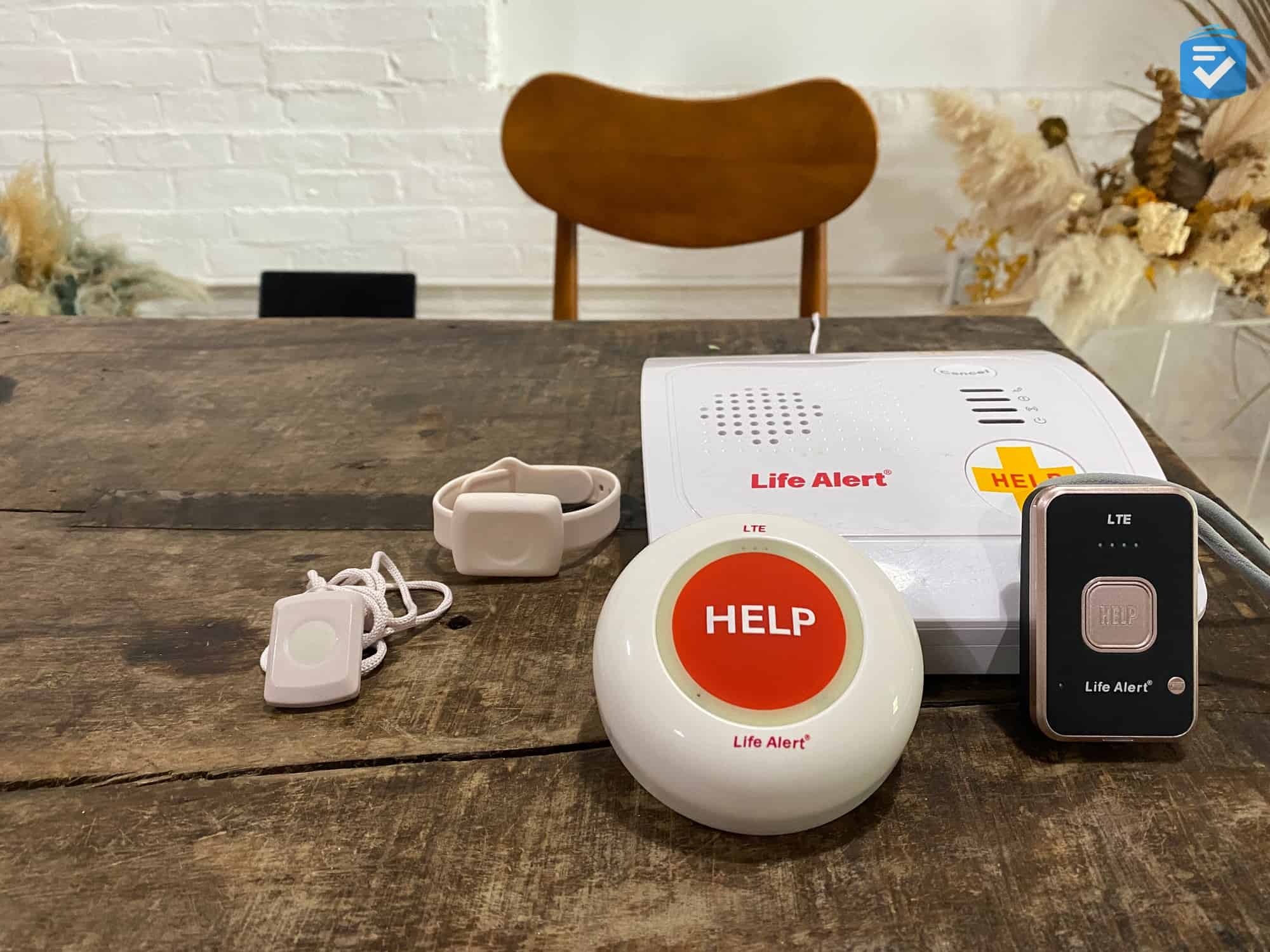Life Alert vs. Medical Guardian: a Hands-On Comparison

Key Findings
- Both Life Alert and Medical Guardian offer in-home and mobile medical alert systems for seniors.
- In our tests, Medical Guardian response agents answered the phone in an average of eight seconds, while Life Alert agents took an average of two minutes. (You read that right: two whole minutes.)
- Life Alert systems cost $49.95 to $89.95 per month, while Medical Guardian’s cost $31.95 to $46.95 per month.

Why Trust TheSeniorList?
At TheSeniorList, our team of caregivers, experts, and health-care professionals conducted over 5,000 hours of in-depth research and testing to recommend the most reliable brands and devices. In this process, our team:
- Tested 50 medical alert devices from 15 different brands.
- Surveyed 1,250 seniors and caregivers on medical alert system usage.
- Consulted with nurses, EMTs, and caregivers who are experts at caring for older adults.
- Published dozens of videos that demonstrate our medical alert system testing.
- Evaluated verified customer reviews of medical alert companies from the Better Business Bureau.
How We Test Medical Alert Systems

Most medical alert companies sell a variety of systems, including in-home systems, mobile systems, and smartwatches. Each device has its own unique features, but they all offer the same basic function: connecting a user to help in an emergency. With this in mind, we evaluate every medical alert system on the following criteria:
- Response times: The faster a medical alert system connects you to help, the better. For each system, we performed 10 test calls, counted how long it took to receive a response, and calculated an average.
- Ease of use: In an emergency, it’s important that a user can successfully activate their system. So, we carefully evaluated each device’s design — with simplicity at the forefront.
- Customer care: A human touch is key to caregiving. With this in mind, medical alert companies must offer impeccable customer service — from the agents at their monitoring centers to their support personnel.
- Pricing and contracts: We analyze device costs, subscription costs, contract requirements, and other fees associated with a medical alert system purchase.
- Extra features: We test out voice commands, caregiver apps, fall detection, activity monitoring, and any other features included with a medical alert system.

|

|
|
|---|---|---|
| Editor's Ratings | ||
| Starting cost | $49.95 per month | $31.95 per month |
| Contract length | 3 years | 1 month |
| Fall detection | Not available | Yes, $10 per month |
| Caregiver portal | Not available | Yes |
| Contact | ||
| Phone Number |
Call for best price:
877-947-4512 |
|
| Website | View Packages Links to Medical Guardian |
In terms of medical alert providers, Life Alert and Medical Guardian are among the most popular options; however, the two providers differ greatly in terms of devices, costs, and their features.
For most users, we recommend Medical Guardian over Life Alert. In almost every area of comparison, Medical Guardian offers a superior product at a better price point. Keep reading to learn about our experience with these two medical alert providers.
FYI: While Medical Guardian is certainly more affordable than Life Alert, it’s not the most affordable medical alert company. To find providers from $20 per month, read our rundown of the best medical alert systems.

Life Alert vs. Medical Guardian: Systems
In terms of the devices themselves, Medical Guardian offers five systems, while Life Alert offers three. While more systems is not necessarily a better thing, it does mean that Medical Guardian can cater to a wider range of users.
The most notable difference would have to be Medical Guardian’s smartwatch, the MGMove.
Life Alert Systems

Life Alert offers a basic in-home system that includes a base unit, a help button, and both pendant and wristband attachments for the help button. To place an emergency call, you press the help button and communicate through the base unit’s speakerphone.
Life Alert also offers a wall-mounted help button and a mobile unit. The wall-mounted help button is made for in-home use. Featuring an adhesive backside and a built-in speakerphone, it can ideally be placed on one’s nightstand, beside the stairs, or near the shower.
The mobile unit features a built-in GPS and speakerphone, allowing you to take the device outside of the home. Most notably, this mobile unit has a disposable battery that Life Alert claims will last up to 10 years. Naturally, we have no way to test this (as we’ve only had our device for one year); however, it still functions as of this writing. Compare this to most mobile medical alerts that have rechargeable batteries that last for several days before requiring a charge.
FYI: Life Alert’s mobile unit has a long battery life, but it’s far from our favorite. To find mobile medical alerts with fall detection, caregiver apps, and health tracking, check out our rundown of the best GPS medical alerts.
Medical Guardian Systems

Similar to Life Alert, Medical Guardian has in-home systems (both landline and cellular) as well as mobile systems (the MGMini, MGMini Lite, and MGMove smartwatch). On paper, these systems will function identically to Life Alert’s (we’ll get to the actual performance later).
One thing that Life Alert does not offer is any type of smartwatch medical alert. Medical Guardian’s MGMove provides medical alert functionality in the discreet profile of a watch. The MGMove can also track your steps and send messages to loved ones.
Overall, with the exception of the smartwatch, Life Alert and Medical Guardian offer relatively similar devices; however, they perform slightly differently.
Life Alert vs. Medical Guardian: Response Times
At their core, medical alert systems are devices made for emergency communications. Whether they are used at home or on the go, a medical alert’s primary function is to connect the user to emergency response agents. Because of this, we always test exactly how long a system takes to connect a user to help.
Across all of Medical Guardian’s different systems, we found that their monitoring center picked up our distress calls in an average of eight seconds. This is one of the fastest average response times we’ve seen across all medical alert providers, and it makes us feel comfortable recommending Medical Guardian to any type of user.
To learn more about our Medical Guardian tests, read our full Medical Guardian review.
Life Alert, on the other hand, took far longer to respond. In our tests across their devices, we found that Life Alert took an average of two minutes to answer our distress calls. While two minutes might not seem like a long time, it’s far longer than any other medical alert system we’ve tested.

To watch one of our Life Alert tests, watch the video below.
Life Alert vs. Medical Guardian: Features
In terms of features beyond emergency calls, Medical Guardian systems once again triumph over Life Alert’s.
All Medical Guardian systems (save for the smartwatch) are compatible with fall detection, which can automatically sense when a user falls and place a call to the monitoring center. While this service does cost an extra $10 per month, it’s worth it for many users. Life Alert, however, does not offer this feature on any system.

Another feature not offered by Life Alert is a caregiver app. So while their mobile system does have a built-in GPS, caregivers do not have access to any sort of location data.
With Medical Guardian’s MyGuardian app, loved ones can keep track of a user’s device location, battery life, and even step count.
In terms of extra features, Medical Guardian handily beats Life Alert.
Life Alert vs. Medical Guardian: Costs and Contracts
For many users, the biggest sticking point with Life Alert will be its costs and, more importantly, their contracts. Both Life Alert and Medical Guardian lease their equipment to users. So, rather than buying the devices, you simply pay a monthly fee that covers both your equipment and monitoring services.
For Life Alert, costs start at $49.95 per month for their basic in-home system. The wall-mounted help button and mobile unit cost an additional $20 per month, respectively. That said, neither the mobile unit nor wall button can be purchased alone; rather, they have to be paired with the in-home system. This means that, depending on which combination of devices you choose, Life Alert will cost you $49.95 to $89.95 per month. Additionally, you’ll have to pay a one-time activation fee up to $198.
Medical Guardian costs start at $31.95 per month for their basic in-home system, and their mobile systems start at $39.95 per month. Additionally, each of their systems (save for the landline system) requires an activation fee, ranging from $149.95 to $199.95.
No matter which system you choose, Medical Guardian will be the more affordable medical alert system.
Contracts
Arguably, the worst facet of Life Alert would have to be its approach to contracts. While Medical Guardian (and virtually every medical alert provider) allow you to pay on a month-to-month basis, canceling at any time, Life Alert locks you into a three-year contract, one that can only be exited through the user’s death or transition to round the clock care.
Not only does Life Alert cost more than Medical Guardian, but it will also lock you into making monthly payments for years to come.
Our Verdict
In every area we evaluated, Medical Guardian bests Life Alert. Their systems are more affordable than Life Alert’s, they have more features, and they work more efficiently. Because of this, we’d recommend Medical Guardian for any type of user.

